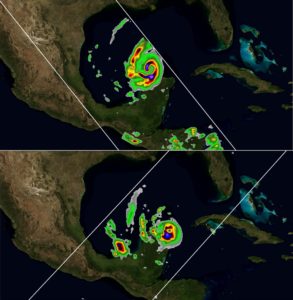
When it comes to Steve Reising’s passion for the new science of weather forecasting, the sky is the limit.
For more than a decade, the professor of Electrical and Computer Engineering has been leading research on small, experimental, low-cost cube satellites, called CubeSats, that capture beautifully detailed images of global weather from low-Earth orbit.
Now, Reising has received a $1.2 million NASA Advanced Component Technology grant that will allow him to take his work a step further and play a key role in fundamentally improving the accuracy and stability of microwave instruments for future satellite missions.
Working with partners at Duke University, the National Institute of Standards and Technology, or NIST, and Northrop Grumman, he will develop new microwave calibration techniques for CubeSats – a next generation technology that could transform weather prediction by enabling more frequent measurements of Earth’s atmosphere by constellations of CubeSats.
Need for small but mighty satellites
For years, large polar-orbiting satellites have been providing visible, infrared and microwave images of clouds to help forecasters predict weather.
While these expensive, long-lasting satellites are the cornerstone of climate measurements, they have limitations, from their size to cost to how often they collect data over a given area of the Earth.
As scientists look to the future of weather forecasting, organizations such as the National Oceanic and Atmospheric Association, or NOAA, are interested in exploring smaller, low-cost, low-power satellite systems.
Leveraging findings from his previous work with small satellites performing global measurements for weather forecasting, Reising and his collaborators are proposing a solution that could enable a new generation of small satellite constellations that would fly in a train about 300 miles above the Earth, capturing detailed images of weather every hour or so.
Taking CubeSats to next level
Through this project, Reising’s team aims to overcome the barriers of changing satellite temperatures as it goes in and out of Earth’s shadow by improving a process called calibration – a technique that converts measured voltages from circuits, or digital counts, into meaningful data.
Small and light enough to fit in a CubeSat, they propose two technology developments to enhance microwave imagers and sounders. Reising is working closely with Duke to create a new calibration target composed of lightweight materials that work as a microwave absorber to calibrate the effect of fluctuating temperatures in space. At the same time, he is drawing on NIST’s long-standing expertise in microwave radiometer calibration to develop new technology standards that will enhance instrument evaluation, increase data repeatability among instruments, and enable constellations of CubeSats to provide microwave sounding data on a more frequent basis. In addition to representing a major step forward for the microwave community, the work will enable effective calibration and traceability between microwave instruments on satellites in space.
“We’ve learned in a lot in the last decade and know what it takes to get to space,” said Reising. “I am excited about the opportunity to advance our technologies and demonstrate the next level of calibration for CubeSats capable of performing well-calibrated, stable observations for weather forecasting.”